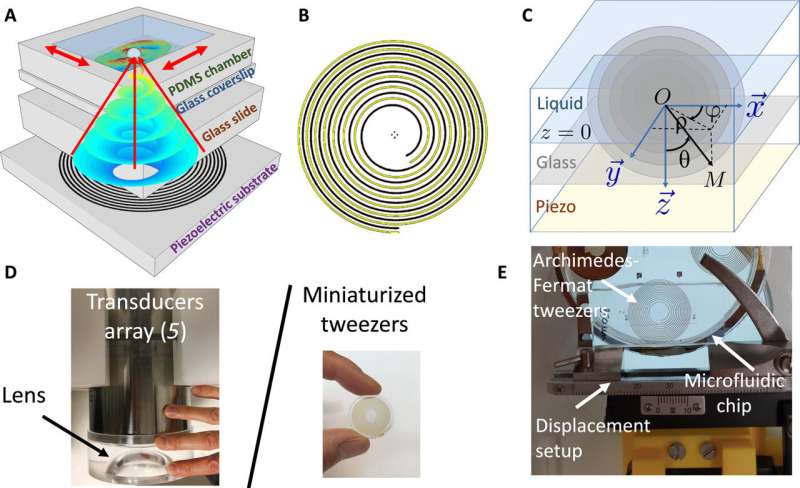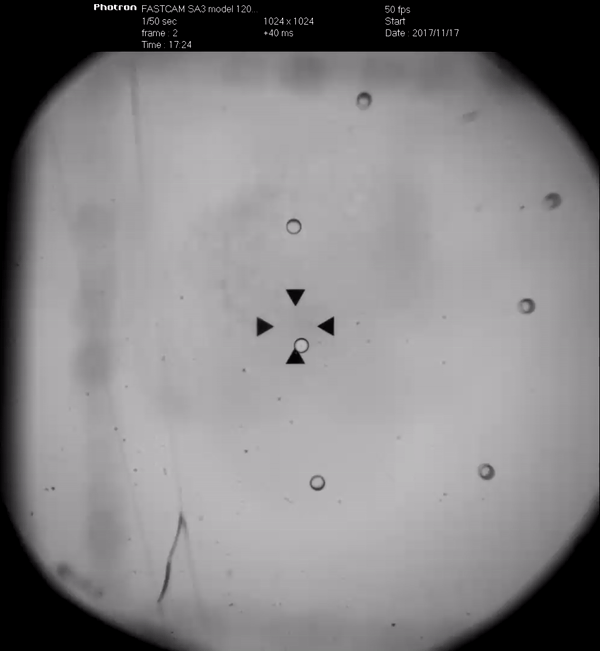April 18, 2019 feature
Folding an acoustic vortex on a flat holographic transducer to form miniaturized selective acoustic tweezers

Acoustic tweezers are based on focused acoustic vortices and hold promise to precisely manipulate microorganisms and cells from the millimeter scale down to the submicron scale, without contact, and with unprecedented selectivity and trapping force. The widespread use of the technique is hindered at present by limitations to the existing systems stemming from performance, miniaturization and the inability to assimilate in compartments. In a recent study, Michael Baudoin and colleagues at the Sorbonne University and the French National Center for Scientific Research (CNRS), improved the potential of focused acoustic vortices by developing the first flat, compact and paired single electrode focalized or focused 'acoustical tweezer'.
The invention relied on spiraling transducers that were engineered by folding a spherical acoustic vortex on a flat piezoelectric substrate. Baudoin et al. demonstrated the ability of these acoustic tweezers to grab and displace micrometric objects within a microfluidic environment with unique selectivity. The system is simple and scalable to higher frequencies; opening tremendous perspectives in microbiology, microrobotics and microscopy. The results are now published in Science Advances.
The first reported observations of partial levitation in acoustic wave fields date back to the work of Boyle and Lehmann in 1925. Precise and contactless manipulation of physical and biological objects at the micrometer scale down to the nanometer scale has promising applications in the modern, diverse fields of microrobotics, tissue engineering and micro/nanomedicine. Acoustic tweezers are a prominent technology to accomplish the task as they are noninvasive, biocompatible and label-free. They are also able to trap forces that are several orders of magnitude larger than their optical counterparts, at the same actuation power. However, only recently have scientists simultaneously developed advanced wave synthesis systems, microfluidic setups and the theory of acoustic radiation pressure, to allow the potential of acoustophoresis (motion with sound) to be harnessed.
Until recently a majority of acoustical tweezers relied on a single, or set of orthogonal standing waves to create a network of nodes and antinodes to trap particles. While these systems were highly efficient for the collective manipulation of particles and cells, the system prevented specific selectivity. While limited localization of the acoustic energy could be achieved using the original sub-time-of-flight technique, only the strong focus of wave fields could allow specific selectivity at the level of the single particle.

Focused acoustic waves are therefore natural candidates to achieve this level of localization but many particles of interest (cells and rigid fragments) can migrate to the standing wave nodes to be expelled from the wave focus, thwarting research efforts on engineering a selective acoustical tweezer. While a wealth of systems were previously proposed to synthesize acoustic vortices, the ability to retain a 3-D trap and pick a specific particle independently of its neighbors was only recently demonstrated using a strong focused acoustic vortex. Acoustic vortices thus synthesized rely on transducer arrays or passive systems that are cumbersome and incompatible within microsystems (microfluidics and microchips).
In the present work, Baudoin et al. therefore harnessed the potential of selective acoustic tweezers by folding the phase of a focused acoustic vortex on a flat surface. To accomplish this, they followed the principle of Fresnel lenses and synthesized acoustic vortices with single spiraling interdigitated electrodes deposited at the surface of a piezoelectric substrate. They materialized two equiphase lines using the electrodes to represent the folded phase on two discrete levels. The shape of the electrode was similar to an Archimedes-Fermat spiral, where its radial contraction allowed wave focusing without the requirement of a curved transducer or lens, as a major advantage compared to existing systems. Baudoin et al. were also able to overcome all limitations of the previously demonstrated cylindrical vortex-based tweezers to presently demonstrate higher selectivity. In the study, the scientists used the development to:
- Measure the acoustic field with a laser interferometer and quantify the fast-radial decrease of secondary rings (rings of weaker amplitude that can impede selectivity) in the system, and
- Selectively trap and move one particle independently of its neighbors within a standard microfluidic environment, demonstrating its practicality.

The scientists designed the experimental system to synthesize focal vortices at a frequency of 4.4 MHz, with spiraling metallic electrodes that were deposited at the surface of a Y-36 niobate lithium (LiNbO3) piezoelectric substrate. To drive the vibration of these spiraling electrodes the scientists used a waveform generator and an amplifier for beam convergence during the experiment within an aqueous microfluidic setup consisting of a glass coverslip and polydimethylsiloxane (PDMS) chamber. They ensured better transmission of acoustic energy from the glass to the liquid in the experimental setup and used a Polytec laser vibrometer to measure the resulting acoustic field at the surface of the glass coverslip.
In the experimental setup, Baudoin et al. used metallic electrodes deposited on the surface of the piezoelectric substrate to synthesize converged Hankel beams of finite aperture. They excited each electrode to provoke localized vibrations on the piezoelectric substrate and produce a bulk acoustic vortex inside a glass slide. In this holographic method, they combined several concepts in the field of microelectronics, including the underlying physical principles of Fresnel lenses in optics, the specificity of Bessel beam topology and the principles of wave synthesis with interdigital transducers (IDTs).

Spherical acoustic Bessel beams are spherical vortices that form excellent candidates to create a localized acoustic trap. Mechanistically, these acoustic fields can focus the acoustic energy in 3-D to create a shadow zone in the vortex center surrounded by a bright shell to trap particles. Much like a plane standing wave is a combination of two counterpropagating traveling waves, a spherical Bessel beam results from the interference between a converging and diverging spherical Hankel beam.
As a result, a Bessel beam can be experimentally produced by a single Hankel converging beam that interferes with its diverging counterpart generated at the focus, i.e. within the vortex central singularity. Due to the piezoelectric effect, the scientists were able to couple the mechanical vibrations of the bulk acoustic waves to the electric potential and model the electrodes as perfect wires (isopotential lines). Using the two electrodes, Baudoin et al. discretized the folded phase on two levels to form the acoustic tweezers.
The scientists compared the acoustic field measured experimentally with the numerical predictions obtained from the angular spectrum method to show excellent agreement between both, for the intensity and phase of the wave field. They compared the experimentally measured and averaged radial evolution of the ring's intensity to (1) the radial evolution of a cylindrical vortex (red) and (2) the radial evolution of a spherical vortex (blue). The results showed that since the radiation pressure was proportional to the beam intensity, the selectivity was greatly enhanced by axial focusing of the beam compared to cylindrical vortices. In this way, the scientists showed 3-D focalization of the energy as a major advantage to selectively manipulate the particles.

To demonstrate the acoustical tweezer's ability to pick a particle and move independently of its neighbors, Baudoin et al. dispersed monodisperse polystyrene particles with a radius of 75 ± 2 µm inside the microfluidic chamber with a height of 300 µm. The tweezers picked a specific particle made of polystyrene, where the weak density and compressibility of particles contrasted with the surrounding liquid. According to a previous report the trapping force exerted on solid particles by a first-order Bessel beam strongly relied on the contrasting density and/or compressibility; weaker the contrast – weaker the trapping force. Only the particles trapped at the center of the vortex moved, while the others remained still. Using the technique, the scientists demonstrated the ability of the tweezer to precisely position a set of 18 polystyrene particles with a radius of 75 ± 2 µm starting from random distribution in to a prescribed pattern to spell 'MOV' (Moving Objects with Vortices).
In total, Baudoin et al. lifted existing restrictions of acoustic tweezers that had thus far forced a trade-off between selectivity and miniaturization or integration, preventing their applications in microfluidics and microbiology. They overcame the limitations through (1) acoustic trapping with focused vortices, (2) holographic wave synthesis with IDTs and (3) integration of the principles of Fresnel lenses within a single, compact and transparent miniaturization device.
Using the microsystem, the scientists demonstrated contactless manipulation of particles within a standard microscopy environment with state-of-the-art selectivity. Due to the simplicity of the technology and scalability to higher frequencies, the work can pave the way towards individual manipulation and in situ assembly of physical and biological micro-objects.
The rigorous demonstration of real 3-D trapping with a progressive wave will require the elimination of any standing waves that may appear from wave reflections in a confined setup. The practical demonstrations of 3-D trapping capacity of the Archimedes-Fermat tweezers will present an interesting perspective in microrobotics, tissue engineering and nanomedicine.
More information: Michael Baudoin et al. Folding a focalized acoustical vortex on a flat holographic transducer: Miniaturized selective acoustical tweezers, Science Advances (2019). DOI: 10.1126/sciadv.aav1967
Diego Baresch et al. Three-dimensional acoustic radiation force on an arbitrarily located elastic sphere, The Journal of the Acoustical Society of America (2013). DOI: 10.1121/1.4770256
Jinjie Shi et al. Acoustic tweezers: patterning cells and microparticles using standing surface acoustic waves (SSAW), Lab on a Chip (2009). DOI: 10.1039/b910595f
Journal information: Science Advances , Journal of the Acoustical Society of America , Lab on a Chip
© 2019 Science X Network




















